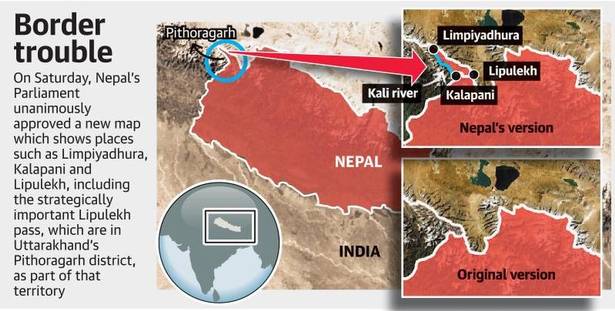Why in news?
Nepal's Oli government has passed the constitutional amendment ratifying a change in its map which includes India's territories in Uttarakhand’s Pithoragarh district.
What is the dispute over?
- The new map includes Lipulekh, Kalapani and Limpiyadhura, territories that India controls. [Click here to read on Kalapani territorial issue]
- The territorial dispute stems from the fact that Nepal claims the land to the east of river Kali, which forms its western border.
- As per Kathmandu’s understanding, the river originates from Limpiyadhura in the higher Himalayas.
- It is thus said to give Nepal access to a triangular-shaped land defined by Limpiyadhura-Lipulekh and Kalapani.
- India opposes the notion and says the origin of the river is much further down (to the east), which reduces Nepal’s territorial demand.

What is the recent trigger?
- While the issue is an old one, it resurfaced in 2019. [Click here to know more]
- In 2019, New Delhi published new political maps to reflect some changes.
- This was following the decision on 5 August 2019 to reorganise the State of Jammu and Kashmir.
- Nepal objected to this depiction of disputed territory.
How are the responses?
- In 2000 and 2014, India and Nepal agreed to hold talks about Kalapani and Susta, without much success.
- [Susta is a disputed village near Bihar on which both India and Nepal stake a claim.]
- Matters became worse when India’s Defence Minister inaugurated a surfaced road over the Kalapani territory.
- When Nepal protested, Indian Army Chief, General Naravane, suggested it was at the “behest” of China.
- Lack of diplomatic manoeuvring to allow a step back from the tensions is primarily widening the rift.
- New Delhi contends that it was willing to discuss matters “at a mutually convenient date.”
- Kathmandu says that India's Ministry of External Affairs (MEA) has rejected two dates suggested by Nepal's Ministry of Foreign Affairs.
- It is said that India had routinely dismissed requests from the Nepal Ambassador for a meet with the Foreign Secretary.
- The MEA said Kalapani talks could wait until both countries had dealt with the coronavirus pandemic first.
- This further enraged the Oli government in Nepal.
- For India, the timing with India-China border stand-off further adds to the belief that Oli is backed by Beijing.
How does the future look?
- Regardless of the accusations on who is more responsible for the downslide in ties, Nepal's quick move on the amendment leaves little space for diplomacy now.
- The fact that the vote was unanimous implies the futility on India's part to portray Mr. Oli alone as wholly responsible.
- The Indian government has in the past not hesitated to take tough measures.
- E.g. the 2015 blockade that severely affected land-locked Nepal
- The Oli government seeks to build its legacy by overturning what it calls “unequal” agreements made by the earlier monarchy.
- It could thus reverse old commitments on open and unsecured border posts.
- In turn, it could cause a security nightmare for India if Nepal opens up other parts of their long boundary.
- Both sides moved quickly to manage the recent fallout of border firing by Nepali police on a group of Indians that left one dead.
- The same readiness is needed now to manage the fallout of the recent amendment vote.
- Both sides should cooperate to preserve the once celebrated “special” relationship between India and Nepal.
Source: The Hindu
Related Article: India-Nepal Relationship - Kalapani Issue
